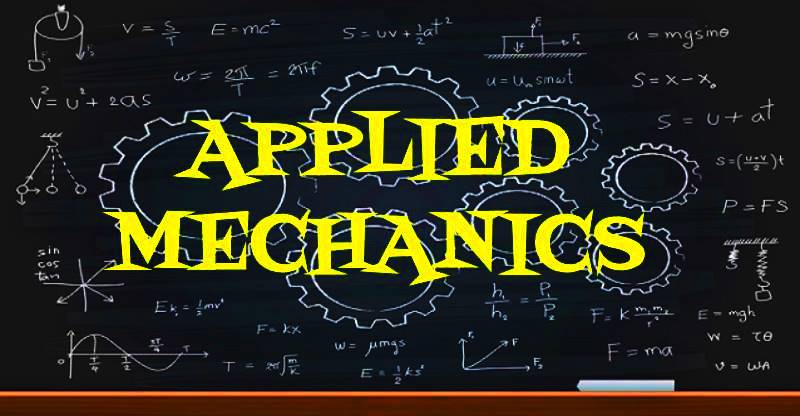MOMENT
PARALLEL FORCES:
The forces whose line of action are parallel to each other are called parallel forces
If the forces, having line of action parallel to each other, act in the same direction, then the forces are called Like Parallel Forces.
If the forces, having line of action parallel to each other, act in the opposite directions, they are called Unlike Parallel Forces.
RESULTANT OF PARALLEL FORCES:
The resultant of parallel force can be found by any of the following methods:
- Parallelogram law of forces method.
- Moments method.
- Graphical method.
-
PARALLELOGRAM LAW OF FORCES METHOD
-
RESULTANT OF TWO LIKE PARALLEL FORCES:
-
Let us consider two like parallel forces F1 and F2 acting at points A and B. The two forces are represented by lines AE and BG. At points A and B introduce two equal and opposite forces having magnitude F. These are represented by lines AC and BD. Due to these introduced forces the equilibrium of the system will remain undisturbed.
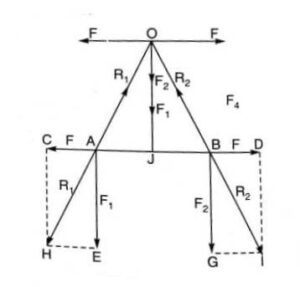
Diagram
Complete the parallelogram ACHE and BDIG. Let R1 and R2 be the resultant of forces at A and B respectively by line AH and BI. Let the two resultants R1 and R2 meet at point O, when produced backward. At point O, resolve R1 into forces F1 and F and R2 into forces F2 and F. Two forces F at O cancel each other while the resultant of F1 and F2 is obtained as the forces F1 + F2, since both the forces act in the same direction and along the same line of action.
Thus the resultant of two like parallel forces is equal to their sum i.e. F1 + F2 having the direction similar to that of forces.
To find out the point of application of the resultant force, consider similar △ AHE and △ AOJ.
AE/HE = OJ/AJ
F1/F = OJ/AJ
F1 x AJ = F x OJ
Similarly considering similar △ BIG and △ OBJ.
BG/GI = OJ/JB
F2/F = OJ/JB
F2 x JB = F x OJ
Putting the value of F x OJ , we get
F1 x AJ = F2 x JB
F1/JB = F2/AJ
Thus it can be said that the resultant of two like parallel forces is equal to the sum of the forces and it acts at such a point which divides the internal distance between the forces in the inverse ratio of their magnitude.
F1/F2 = JB/AJ
If F1 = F2 then JB = AJ i.e. if two like parallel forces are equal in magnitude then the resultant will act at the centre of the distance between the two forces.
-
-
RESULTANT OF TWO UNLIKE PARALLEL FORCES:
-
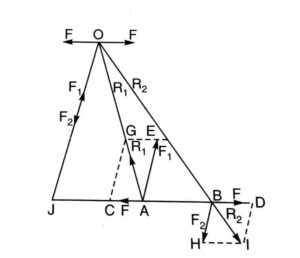
Consider two unlike parallel forces F1 and F2 acting at points A and B. The forces are represented by line AE and BH. At A and B introduce two equal and opposite forces F so that equilibrium of the system remains unaffected.
Now complete the parallelograms AEGC and BDIH. Let R1 and R2 be the resultant forces at points A and B respectively. These two resultant meet at point O when produced.
At point O resolve the resultant R1 into F1 and F and R2 into F2 and F. The two equal and opposite forces at O cancel each other and resultant of the forces F1 and F2 will be F1 – F2.
Thus the resultant of two unlike parallel forces is equal to their difference (F1-F2) and will act in the direction of greater of force. To find out the position of the resultant force consider similar △ AOJ and △ AGC.
GC/CA = OJ/JA
F1/F = OJ/JA
F1 x JA = F x OJ
similarly from △ OJB and △ BHI
BH/HI = OJ/JB
F2/F = OJ/JB
F2 x JB = F x OJ
Putting the value of F x OJ, we get
F1 x JA = F2 x JB
F1/F2 = JB/JA
This shows that J divides the line JAB externally in the inverse ratio of the forces.
-
MOMENTS METHOD
LIKE PARALLEL FORCES: Let P and Q be the two parallel forces acting at point A and B. Thus their resultant R = P + Q acts in the direction of the forces. To find out the position of the resultant, take moment of the forces about the point C.
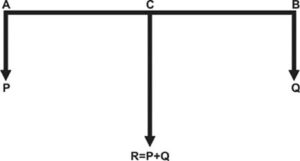
According to the principle of moments
P x AC = Q x BC
[frac up=”P” down=”BC”] = [frac up=”Q” down=”AC”]
UNLIKE PARALLEL FORCES: Let F1 and F2 (F2>F1) be the two forces acting at points A and B. Thus their resultant R = F2 – F1, acts in the direction of the greater force F2. Let the resultant force R be acting at point C situated outside AB.
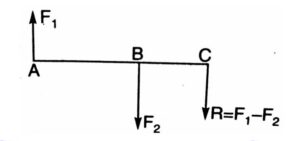
Taking moment of all the forces about point C.
F1 x AC = F2 x BC
[frac up=”F1” down=”BC”]= [frac up=”F2” down=”AC”]
-
GRAPHICAL METHOD
Consider a number of parallel forces (say three like parallel forces) P1, P2 and P3 whose
resultant is required to be found out as shown in figure
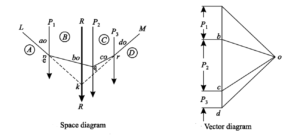
First of all, draw the space diagram of the given system of forces and name them according to Bow’s notations. Now draw the vector diagram for the given forces as shown in Fig. and as discussed below :
1. Select some suitable point a, and draw ab equal to the force AB (P1) and parallel to it to some suitable scale.
2. Similarly draw bc and cd equal to and parallel to the forces BC (P2) and CD (P3) respectively.
3. Now take some convenient point o and joint oa, ob, oc and od.
4. Select some point p, on the line of action of the force AB of the space diagram and through it draw a line Lp parallel to ao. Now through p draw pq parallel to bo meeting the line of action of the force BC at q.
5. Similarly draw qr and rM parallel to co and do respectively.
6. Now extend Lp and Mr to meet at k. Through k, draw a line parallel to ad, which gives the required position of the resultant force.
7. The magnitude of the resultant force is given by ad to the scale.
RELATED VIDEOS:
